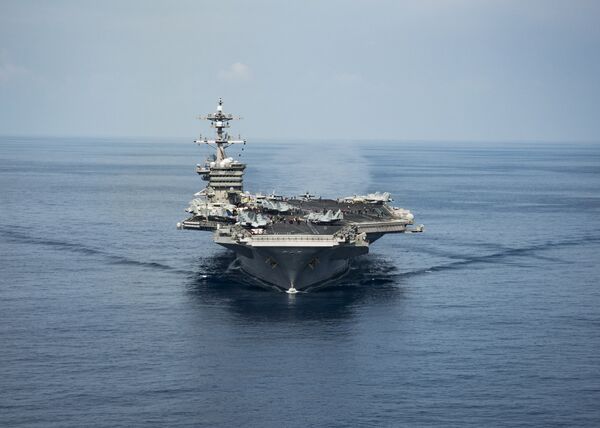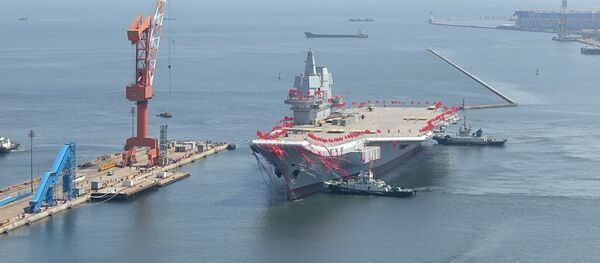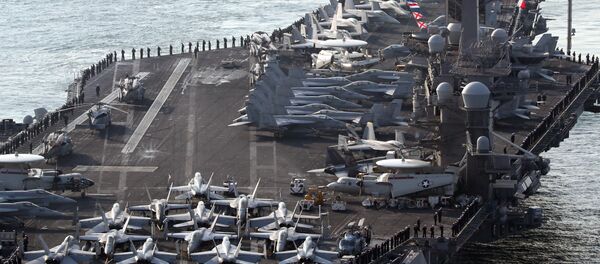By launching its second aircraft carrier — and the first one entirely homebuilt — known as the Type 001A, Beijing has signaled its willingness to become a "global power," German newspaper Die Welt believes.
"With the first aircraft carrier made by its own hands, Beijing sends a message: 'We want to become a global power'… Paris and London can afford only one or two such expensive vessels. China wants much more. The launch of the vessels has marked the birth of a fleet which up until now only the US possessed. This is not an empty promise," the newspaper said.
Make no mistake, the newspaper says, by 2030 there will be two global naval powers competing for dominance in the world, China, and the US.
Meanwhile, the Chinese English-language media outlet Global Times calls attention to the fact that Beijing has made remarkable progress.
"The homegrown aircraft carrier involves 8,000 technological breakthroughs and some industrial standards in advanced manufacturing sectors, such as electronic equipment, power plants and steel products that have been developed in the wake of the project," Liu Xuezhi, a senior analyst at the Bank of Communications, said as quoted by the media.
Beijing launched its first aircraft carrier, the Liaoning — a refitted former Soviet Union-era ship — back in 2012. The vessel conducted live-fire drills for the first time in November 2016. The construction of the Type 001A began in November 2013.
Does it really mean that Beijing is seeking naval dominance?

Commenting on the historic launch, Ma Xiaoguang, spokesperson of the Taiwan Affairs Office of the State Council, stressed that the vessel is aimed at boosting the country's national security.
"[The launch of the new carrier] will help strengthen our capability to safeguard national sovereignty, territorial integrity, as well as major and core interests," Ma said.
During a regular press briefing held by China's Ministry of National Defense (MND) on April, 27 journalists asked MND's spokesperson, Senior Colonel Yang Yujun, whether Beijing is planning to build military bases around the world to support the operations of the Chinese aircraft carriers.
"The main offshore support facilities for aircraft carriers include the home ports for aircraft carriers, the airfields for aircraft and the training and supporting facilities. They are the main facilities supporting the aircraft carrier troops to carry out daily activities," Yang responded.
"You just mentioned that naval bases should be built all over the world because China has aircraft carriers. I think you think too much," he stressed.

However, it hasn't gone unnoticed by international observers that the launch of the Type 001A from the Chinese port closest to North Korea coincided with the USS Carl Vinson and its strike group's drift towards the Korean Peninsula.
Tensions over the North Korean nuclear program continue to simmer while Washington's tough rhetoric is only adding fuel to the fire.
Appearing before the Senate Armed Services Committee (SASC) on Thursday US Pacific Commander Admiral Harry Harris Jr. signaled that the "military option" toward North Korea is still on the table.
"I believe the president has said that all options are on the table," Harris said responding to South Carolina Republican and SASC member Lindsey Graham, who asked him whether it was fair to say that the US does not have any intention of invading North Korea at all.
"The use of force is absolutely unacceptable and fraught with catastrophic consequences for the Korean Peninsula as well as for the entire North-East Asia. We should opt for using whatever diplomatic tools we have," Gatilov warned.
Speaking to Sputnik in late March, US Peace Movement activist and founder of "Show Up! America" Jan R. Weinberg emphasized that it is Washington who is bolstering militarization of the Asia-Pacific region.
"In my opinion, despite unequivocal admonishments from China and North Korea, the expanded military cooperation agreement with Indonesia, the present deployment of the THAAD missile battery to South Korea, the most recent $1.83 billion of arms sales to Taiwan, Japan's Prime Minister Shinzo Abe's push to 'reinterpret' Article 9 of the Japanese constitution which previously prohibited offensive military engagement, the lifting of the US arms embargo against Vietnam, and the expansion of US military bases in the Philippines, were all preplanned militarization aspects of the Obama administration's Pivot to Asia," Weinberg told Sputnik, adding that the Trump administration is following the same path.




